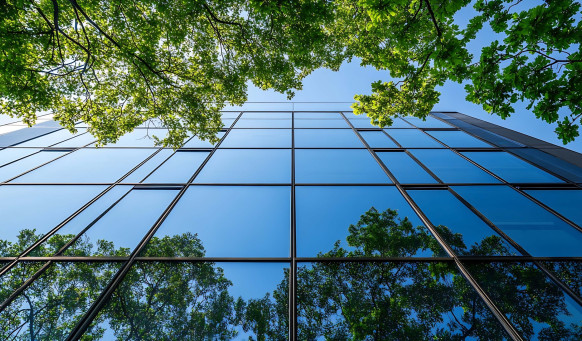Industry Viewpoint
Important health and wellbeing lessons learnt at Futurebuild
Futurebuild has a reputation for being the industry’s must-attend event of the year, so I was keen to experience this for myself and catch up on the latest news and trends in our ever-evolving sector! On the morning of Tuesday 7th March, equipped with our very own Fabrick selfie board, the team and I arrived at Excel in style via the Docklands cable car to begin our support for the exhibition.
After snapping a quick couple of photos between us, my first stop inside was attending two talks about health and wellbeing – delivered by Ann Marie Aguilar, Senior Vice President, Commercial, International WELL Building Institute, Mathew Freeman, Founder of Freeman Studio, BIID President and 7 other impressive speakers (who can be revealed from links included).
They were very insightful and got me thinking about the importance of designing and building with wellbeing in mind – why is it not universally considered as a priority in our buildings?
UNDERSTANDING OUR INDOOR ENVIRONMENTS
It's estimated that we spend approximately 90% of our time indoors (and probably a lot more during the winter months!). [1] With most of us spending as much time at work as at home, the indoor environments in both commercial and residential buildings have a large impact on our overall health and wellbeing.
We’re affected through exposure to environmental factors such as indoor air compounds that manifest themselves via our senses, including through inhalation, ingestion and skin contacts. [2] If conditions are not properly managed, damp and mould can form, leading to an influx of bacteria and subsequent poor health. Other factors include surface contamination with toxins and microbes, and interaction among the various people that share the interior space.
In addition to these, the environment affects us in other subtle ways, physiologically and psychologically. In turn, we can suffer different forms of health effects including irritation of the eyes, nose and throat, headaches, dizziness and fatigue. Furthermore, respiratory diseases, heart disease and cancer can also be serious consequences to our health. Mental health is affected with an increase in symptoms of stress, anxiety and depression.
In my opinion, there is still a clear knowledge gap when it comes to understanding our indoor environments. I believe the construction industry should be leading the way by educating homeowners and businesses about the ways in which they can improve buildings, and ultimately, apply this knowledge in how they choose to build. It all starts in the decisions we make in the design phase and then moves across the lifecycle of a building.
IMPROVING INTERIOR DESIGN DECISIONS
Designing for wellbeing must be made a priority by all parties involved, from architects to building owners. This is achieved both by embedding better design practices for new builds whilst retrofitting and renovating existing building stock.
One of the talks that I attended at the Interiors Stage, ‘Designing for wellbeing – curated by BIID’ (the British Institute of Interior Design [3]), featured a panel of speakers who had suffered health problems attributed to poor interior design decisions of the past. From poor mental health to skin issues, the discussion gave us an insight into how the previous ‘status quo’ for building practices was not backed by the foresight of modern scientific research. Now we know more about the impact of materials such as microplastics, fire retardant chemicals and asbestos, designers and builders can choose less harmful options and make better design decisions for our buildings.
INTEGRATING NATURE
The emphasis in the discussion was placed on choosing natural alternatives, such as timber, stone and bamboo. The benefits of these materials for sustainability are widely recognised, but integrating them into buildings boosts wellbeing too. Studies have shown that having natural products can help relieve stress, increase cognitive abilities and make occupants feel much calmer and centred.
ACHIEVING HEALTHIER INDOOR ENVIRONMENTS
Besides choice of materials, natural ventilation has always been considered the obvious way to improve indoor air quality. Like our lungs, buildings need to be able to breathe as part of a natural process. Proper ventilation keeps the air fresh and healthy whilst removing or diluting airborne contaminants.
At the ‘Understanding Impact – the WELL Equity Rating – curated by International WELL Building Institute’ seminar, (delivered by a range of keynote speakers from different specialities within construction), they discussed how although the rating priorities the essential need for greater diversity and parity for women within organisations, it also gives businesses an actionable framework to improve access to health and wellbeing in the workplace. [3] In doing so, it sets out how to achieve healthier indoor environments by fostering connections through nature.
Notably, the power of natural light was mentioned as a way of healing instead of hindering health. Exposure to natural light helps our bodies produce vitamin D, improves our circadian rhythms and sleep patterns, helps us to focus, enables us to get more done and even makes us happier.
THE WAY FORWARD
From personal experience, I’ve definitely noticed a positive difference living and working in open, bright and well-ventilated spaces. The requirements for optimising indoor environments may differ between our homes and the larger public spaces that we share, however, across the entire built environment, health and wellbeing can be improved with better design decisions and a greater understanding of best practice industry-wide. Integration, not isolation from the natural environment, can help to create healthier, happier interior spaces for all.
References:
[1] The National Human Activity Pattern Survey (NHAPS): A Resource for Assessing Exposure to Environmental Pollutants
[2] The Healthy Indoor Environment: How to assess occupants’ wellbeing in buildings: https://shorturl.at/cnpZ2
[3] WELL Equity Rating, International WELL Building Institute https://v2.wellcertified.com/en/equity-rating/overview
Understanding Impact – the WELL Equity Rating – curated by International WELL Building Institute speakers: Ann Marie Aguilar, Senior Vice President, Commercial, International WELL Building Institute, Julia Skeete, Senior Associate Principal, Skidmore Owings & Merrill, Cara de Lange, Founder & CEO Softer Success®, Diaa Bahopia, Wellbeing and Social Value Lead, Sweco, John Harrison, President, A SustainAble Production (ASAP)
Designing for wellbeing – curated by BIID speakers: Mathew Freeman, Founder of Freeman Studio, BIID President, Ben Channon, Director, Ekkist, Sharon Simpson, Founder of Sharon Simpson Studio, BIID Member, Chloe Bullock, Founder of Materialise Interiors, BIID Member




